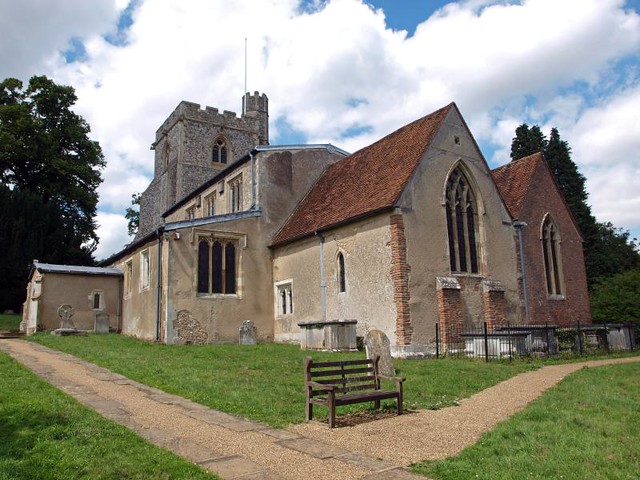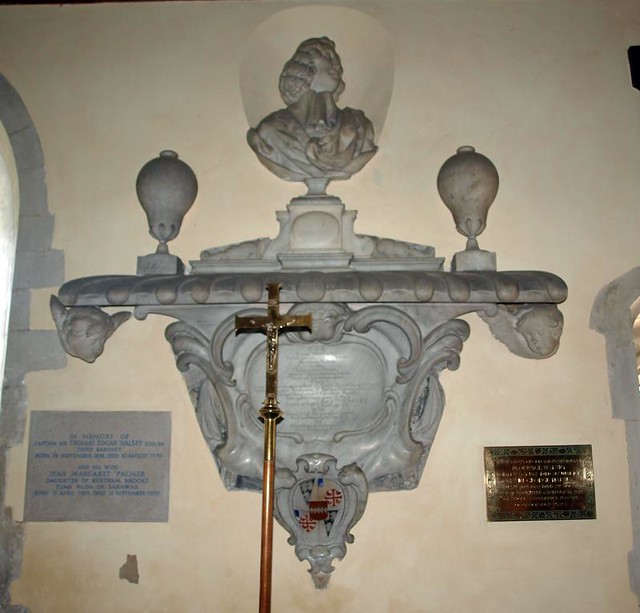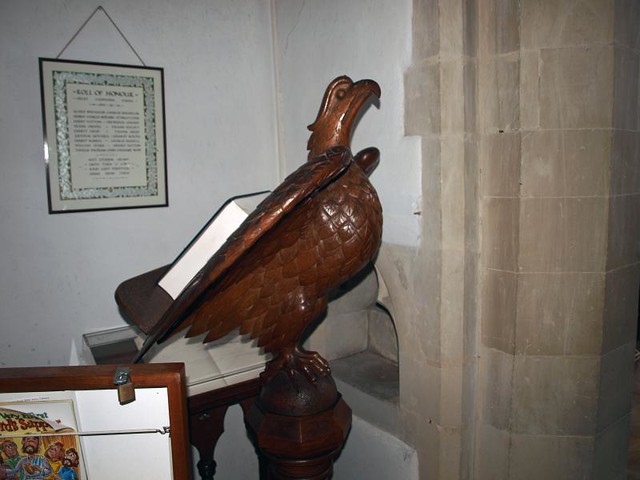ST JOHN THE BAPTIST. On the hillside in a not very attractive village, but well placed against a screen of beech trees with the E end facing the valley. The E end is the chief interest of the church. The visitor sees two gables, the r. one of the brick built N E Halsey Chapel of 1730, the l. one of the C12 chancel (window C19) with quoins and shallow buttresses strengthened with Roman bricks. In the S wall of the chancel is a small C13 lancet window. The nave has arcades of four bays, that on the S side with octagonal piers carrying big stiff-leaf capitals said to be original early C13 work, but drastically re-tooled if not new. The arches are hollow-chamfered. The N arcade has the same arches and moulded capitals. The N aisle E window late C13. The building needs renewed study to clarify its history. S porch, clerestory, tower and nave and aisle roofs are all C15 (tower rebuilt 1861). - PLATE. Chalice, 1637.
MONUMENTS. Brass to William Croke d. 1506 and wife (chancel). - Brass to an unknown woman, c. 1520 (N aisle). - John Halsey d. 1670, exceptionally good Italian-looking epitaph with finely designed cartouche and, on top, a Berninesque bust (chancel). - Thomas H. d. 1715, Anne d. 1719, Jane H. d. 1725, Henshaw H. d. 1739, all four the same dignified design with busts under drapery baldacchinos between pilasters and below open segmental pediments. The sculptor is not recorded. - Charles H. d. 1748, white epitaph with bust against obelisk. - Frederick H. d. 1762, white epitaph with profile medallion against obelisk. - Agatha H. d. 1782, small epitaph with large angel holding a book. By Flaxman, and the only signed monument of this important series. - Thomas H. d. 1788 and wife, with obelisk and on it oval medallion with Mrs H. taken up to heaven.
Great Gaddesden. Londoners off to Whipsnade see its church and the cluster of cottages on the other side of the River Gade, and they will see no fiercer animal at Whipsnade than the gargoyles round the church tower. But it is the Roman bricks that are the marvel here, seemingly as long-lived as the phoenix. The Normans who built this church 800 years ago made use of these bricks, which were then 800 years old, and, though the church changed through the Middle Ages, the flat, red bricks of the Romans still buttress the chancel and form one corner of its walls. On the other side of the chancel is the chapel added in 1730 to house the memorials of the Halseys, whom we found still living at Gaddesden Place, the 18th-century house glimpsed among the trees on the opposite side of the river. Drear and bleak is this chapel where the white busts of six 18th-century Halseys look down on us, secure with their estimable epitaphs. The Latin epitaph of an earlier one, whose handsome bust is niched over an elaborate monument in the chancel, culminates in the ecstatic exclamation, What a husband! What a father!
Two older couples are portrayed in brass, both bereft of their little children: William Croke of 1506 and his wife on the chancel floor, the other couple by the north door. The altar table and the table in the tower vestry are 17th century, and there is a small medieval chest hollowed from a solid log, and an extraordinary narrow one over eight feet long. The south arcade has capitals deeply carved with leaves by 13th-century masons; the plain north arcade is 14th century; the clerestory, the porch, and the tower are 15th; and the roofs are all 500 years old, the handsome nave roof having carved bosses. The chalice was made shortly before Charles I lost his throne, and four of the bells shortly after his son got it back.
The Gade flows on and reaches Waterend, a charming hamlet of a dozen brick and timber cottages from the 17th century; then, emerging from under a pretty bridge, it widens and sobers to match the stateliness of the green slopes up to Gaddesden Place. On the high ground beyond is Gaddesden Row, which provided the British Museum with a fine collection of flints, the tools and hunting weapons of the first of our Stone Age men.
Two older couples are portrayed in brass, both bereft of their little children: William Croke of 1506 and his wife on the chancel floor, the other couple by the north door. The altar table and the table in the tower vestry are 17th century, and there is a small medieval chest hollowed from a solid log, and an extraordinary narrow one over eight feet long. The south arcade has capitals deeply carved with leaves by 13th-century masons; the plain north arcade is 14th century; the clerestory, the porch, and the tower are 15th; and the roofs are all 500 years old, the handsome nave roof having carved bosses. The chalice was made shortly before Charles I lost his throne, and four of the bells shortly after his son got it back.
The Gade flows on and reaches Waterend, a charming hamlet of a dozen brick and timber cottages from the 17th century; then, emerging from under a pretty bridge, it widens and sobers to match the stateliness of the green slopes up to Gaddesden Place. On the high ground beyond is Gaddesden Row, which provided the British Museum with a fine collection of flints, the tools and hunting weapons of the first of our Stone Age men.



No comments:
Post a Comment